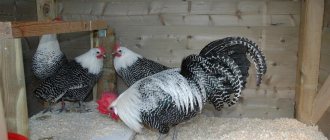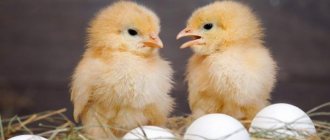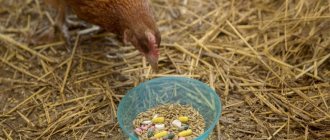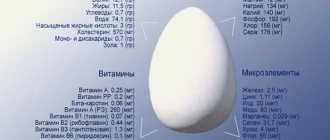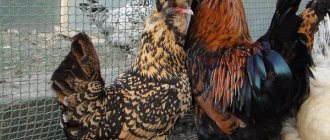2 025
no comments yet
3
Author of the article
Rasskazov Pavel
Reading time: 3 minutes
Surprisingly, the best hens are considered to be outbred laying hens, as well as chickens of meat and meat-egg breeds. Such birds, as a rule, have a well-developed brooding instinct. To hatch chickens, birds aged 2 to 4 years are used. Hens who have already done such work before show their maternal qualities best.
When do chickens lay eggs?
Chickens start laying eggs very early. Egg-bearing breeds can produce their first eggs as early as 4.5 months, and outbred or meat-egg breeds by 5-6.5 months, and only meat breeds produce late egg-laying by 7-8 months of life. Precocity is also influenced by housing conditions, nutrition, and the presence of all the vitamins and minerals in the feed that females need for productivity. If the conditions and nutrition are at a high level, then the female will begin to lay the first eggs on time or even earlier, but poor conditions, on the contrary, delay the development of the bird.
Chickens begin laying eggs from the 5th month of life
Interesting!
In winter, chickens lay fewer eggs or stop laying them altogether. This is a natural process for the bird, because winter is a time of rest. At this time, chickens are placed on eggs in rare cases, because they can leave the nest at any time.
When a hen is ready to start laying eggs, her appearance and behavior may change significantly. The comb acquires a more saturated color and may even become larger. The bird becomes restless or, on the contrary, too calm. From this time on, she begins to lay eggs, which, if there is a rooster, will be fertilized.
Chicks hatching
Chicks hatch from 20 to 23 days. There's no point in waiting any longer. As they hatch, the chicks are taken from their mother and transferred to a box, awaiting all the offspring. Then they take her away from mommy for 24 hours so she can rest and stretch.
The temperature in the chick room should be between 36 and 38 degrees. When their mother is away, the farmer feeds them with crumbled boiled yolks and water. A day later the babies are returned to the hen. From now on, you should not interfere in their lives. Mom can handle raising and feeding the chickens on her own.
How to get fertilized eggs?
Also check out these articles
- Friesian horse
- The best varieties of radishes for a greenhouse
- White spots on eggplant seedlings
- Cherry compote
Before you think about how long a chicken hatches eggs, you need to determine which eggs are suitable for this process. The main question of interest to young breeders is whether a rooster is needed in the chicken coop? Yes, without a rooster it is impossible to get young animals - only a productive male can give good offspring.
A fertilized egg is obtained in the presence of a healthy rooster
Chickens lay eggs easily even without a male, but their eggs are not fertilized and can only be used for food. A fertilized egg is obtained only if there is a healthy rooster in the chicken coop. At the same time, there should be no more than 12 laying hens per male!
Birth of an egg
During embryo development, the chick's body is formed from the required number of eggs. Eggs will hatch. Over the course of her entire life, a laying hen lays from six hundred to three thousand eggs.
Let us list the stages of egg formation:
- The growth of the egg begins.
- The enlarged egg enters the oviduct and separates.
- If during this period of time the hen begins to communicate with the rooster, then the egg will be fertilized, and the embryo in the yolk shell will move along the oviduct.
- Along the way the embryo moves towards the birth tubes, it becomes overgrown with protein and shell.
- This egg can be placed under a hen, which will hatch it.
- If there was no rooster, then the egg will be ordinary.
- After the chicken lays an egg, it is necessary to determine in what capacity it will be used.
The entire laying cycle and the duration of egg laying can be regulated by natural processes. It is noted that about twenty hours will be required to form the protein. The rest of the time is spent on the development of the yolk and the appearance of the shell. After the egg is laid, the development of another egg begins.
How to choose a hen?
The most important thing in the natural process of brooding is the female. The hen chosen for hatching must have a developed maternal instinct, be strong, calm, and assiduous. A young quonka, which is not yet a year old, can also sit on eggs, but the chance of getting good young from it is small. In such cases, the breeder has to control the entire process, constantly monitor the female, eggs, temperature, etc., and this is quite difficult.
Mother hen photo
Important!
Only a healthy, adult hen can cope with hatching eggs!
A strong maternal instinct awakens in chickens at 2-4 years of age. This is the kind of female that is suitable for this process. How many days a hen incubates an egg before hatching will no longer have a big role in this case, because the whole process will depend on the bird - she controls it, and the breeder only needs to feed and water the hen.
A female that is ready to lay eggs usually does not lay eggs, clucks often, and can pluck fluff on her belly and cover the nest with it. Such an individual has a knocked down constitution, but is not heavy in weight for the shell to withstand. A good quonka has abundant plumage so that there is enough warmth, the belly is large, as are the wings, because the bird will use them to cover and warm the eggs.
What to feed the hen?
Chickens spend a lot of energy to heat their eggs. They need a lot of nutritious food. The diet will differ from the typical feeding table of egg or meat chickens. The diet is close to feeding roosters or broiler chickens:
| № | Helpful information |
| 1 | hen grains receive 50 g per day |
| 2 | While walking, chickens peck grass and look for insects and earthworms. The amount of green food is at least 60 g. Instead of green food, individuals can receive vegetables and root vegetables. Boiled potatoes, carrots, beets, pumpkin are good for them |
| 3 | the hen needs to be given protein supplements, cake, yeast - 8 g |
| 4 | fish or bone meal – 6 g |
| 5 | mineral supplements 8 g. As supplements, chickens receive shell rock, chalk, crushed egg shells, crushed shells |
| 6 | The hen drinks water to her heart's content. This is especially true if combined food is used for feeding. |
View this post on Instagram
Posted by Anna (@annabronnikova_) Aug 17, 2021 at 2:43 PDT
It is recommended to make mash for chickens at home. In addition to vegetables, grains, protein fillers, gravel is added to them. Stones improve digestion. For adult birds, choose medium-fraction gravel with a diameter of no more than 3 mm. Chickens should consume up to 2 grams of stones daily.
How is oviposition carried out?
We recommend reading our other articles
- Plum variety Stanley (Stanley)
- Currant variety Dobrynya
- Black and white breed of cows
- Tomato variety Banana legs
Knowing how many days a chicken hatches eggs is very important. This allows you to establish a regular process of producing young animals naturally, without an incubator. Thus, you can get young animals every month! But only under the right conditions can this be realized.
Laying hens photo
- Without eggs there will be no young animals, so it is necessary to select good eggs. The collection takes place within a week, but it can be done faster if the population is large. Selected eggs are stored in storage at a temperature of +15 degrees and a humidity of 75%. In this case, each egg is turned over daily until they are placed in the nest. Only whole eggs are suitable, with a smooth shell, without irregularities, normal shape, color and medium size.
Interesting!
A hen can lay eggs for up to 10 years, but every year she produces fewer and fewer eggs, so laying hens are usually kept on the farm for up to 5 years.
- The nest should be soft so that the eggs do not crack, and also large so that there is enough space. Install it in a quiet, cozy place where no one will disturb the female. The approximate dimensions of the nest are 55x35 cm. The place may be poorly lit, but not completely dark throughout the day. Still, the female may rarely get up from her clutch, and light is very important for her!
It is best to place the female on the nest in the spring, although in principle this can be done at any other time of the year.
How to monitor chick development
While the eggs are hatching, they need to be checked three times using an ovoscope to prevent the birth of weak or sick chicks. The first time monitoring is carried out on the 7th day after the start of incubation - the developing embryo is not yet visible at this time, but blood vessels are clearly visible inside the egg. An embryo that develops incorrectly is clearly visible near the shell, and in a dead one, the vessels are located in the form of a dark ring. Unfertilized eggs will be completely light colored.
An ovoscope is a mandatory attribute of a poultry farmer, with the help of which the development of embryos is monitored.
During the second inspection (day 11), you can see the shadow of the future chicks, which occupies a quarter of the egg. The clutches are examined for the last time on the 18th day - they look like a dark spot, and sometimes movement can be seen. Sometimes the chicken itself throws one or more eggs aside - most likely, the embryos in them are dead, but it is better to check further to avoid mistakes.
Important! All eggs with defective embryos should be removed, and healthy ones should be moved closer to the center. Leaving improperly developing embryos in the nest is impractical - even if the chicks are born, they will be weak and sick.
How many days does a chicken hatch eggs?
Before a chicken is placed on real eggs, she is given two fake ones. You can take plastic or porcelain ones to check whether she will sit on them or not. If the chicken sits without getting up for 2 days, then you can start giving her real, prepared eggs.
The female can hatch 10-15 eggs
One female can hatch 10-15 eggs, but a lot also depends on the size of the chicken, the breed and the eggs themselves. How many days does a chicken hatch eggs? The incubation process generally takes approximately 20-21 days. However, the chicks sometimes do not hatch together, but gradually, over 3-5 days. So if 8 out of 10 chickens hatch immediately, this does not mean that the remaining eggs are bad, you may just need to wait.
Number of eggs to lay
Calculating eggs for lining is the next task of the owner of a hen that hatches chickens. On average, it can hatch up to 15 pieces. It all depends on its size and coverage area. If the extra eggs do not receive proper warmth, the embryos will stop developing and there will be no chicks.
The chicken itself knows how many pieces it can take for incubation. To do this, you need to place 15 eggs next to it. She will move them towards her with her beak, forming a clutch. It is important to ensure that it is a single layer.
Important! You should check how much food the chicken took and remove the excess.
Hatching process
While hatching eggs, the chicken should still receive plenty of food and water. To make it easier for the female, a feeder and drinking bowl are placed next to her nest and they are replenished with food from time to time. The food should be high-calorie, nutritious, with an abundance of vitamins and minerals, so that the chicken, with rare feed consumption, receives all the necessary nutrients.
For the first two days, you cannot touch the hen, otherwise she will leave the nest. This is an important time when the eggs need to be heated to a certain temperature. So there is no need to take risks. But if after the second day the female does not get up to eat, you need to remove her from the nest for 5-10 minutes, take her to food, water, and then put her back on the eggs. This is done very carefully so as not to hurt the bird or damage the eggs.
Important!
Some chicken breeds lack maternal instinct. They do not sit on eggs and therefore can only be bred through laying hens of other breeds (which will take on the role of mothers) or an incubator.
The entire time the hen is hatching her eggs before hatching, she is under great stress. Because of this, she reacts sharply to any unusual noise, temperature, humidity and other similar things. If she gets scared, she will simply get up from the clutch and will not sit on it again for 6-12 months. So she needs to be provided with complete rest.
Caring for a chicken during incubation
During the brooding period, the chicken's activity is significantly limited. Accordingly, the breeder must provide her with proper care. It includes several points.
First of all, you should place a feeder with high-quality grain and a container of water near the nest, from which the chicken can drink or bathe. It is advisable that only the hen herself has access to such food and drink. In this case, it is necessary to install the container at the stage of nest formation, since it is not recommended to disturb the hen in the first and last few days. Food and water containers are washed regularly and their contents are changed.
It is imperative to ensure that the hen leaves the nest from time to time, eats well and drinks enough water. To prevent the eggs in the clutch from cooling down without the chicken, they are covered with a warm cloth until she returns. At the same time, change the dirty bedding.
It is worth noting that the hen’s permanent habitat makes her vulnerable to fleas, lice and other parasites. Therefore, poultry must be regularly checked for their presence and appropriate eradication measures taken.
Attention! When the chicks begin to hatch, sharp shell fragments must be promptly removed. If this is not done, the sharp corners will prick the hen, which may cause it to leave the nest.
How many days maximum does a hen incubate eggs before chick?
Chickens behave differently during laying. Some cannot sit still, others do not leave the nest for days. That is why breeders are often interested in how long a chicken can hatch eggs? If overheated, the first chicks may appear as early as 19 days. This is quite normal and even on the 18th day they can also begin to appear, you should not be afraid - this is natural, given that the egg can lie in the warmest and coldest places. On day 20, a mass hatching of chicks occurs. But on days 21-23 the last chicks appear. They are usually few in number and may be weak, but quite viable. A chicken hatches eggs for a maximum of 23 days before the chick hatches; after this period, the chances of getting chicks are zero.
Hatched chicks photo
Interesting!
Chickens are able to hatch not only their own eggs, but also eggs of other breeds of chickens and even other types of poultry.
During the hatching of eggs, it is advisable to monitor the quons and young animals. Sometimes chicks have a hard time getting out of their shells. They can break it, but not remove it completely. In this case, you can help, but very carefully, with clean hands or a cloth. But if blood appears, the procedure must be stopped immediately! If not all chicks have hatched, it is worth taking those already born into the brooder. Thus, the female will not have to leave the nest to care for the young, and she will continue to incubate the eggs. And when the last chick hatches, it will be possible to return all the young to the female so that she can look after them.
Nest preparation
The roosting house for hatching chicks should be deep and comfortable enough. Large wicker baskets or wooden boxes are best suited for arranging such a house, but only those that have side openings.
During incubation, such holes will serve for good ventilation of the nest. The bottom of the box must be solid and strong so that small rodents do not get into the nest. For greater safety, you can place an iron sheet under the bottom of the box.
The nest for the hen should be placed separately, ideally in a separate room. Then the peace of the mother and her future children will not be disturbed by other birds, pets, or small children.
The bottom of the box or basket is covered with fresh straw or hay. You need to put quite a lot of bedding - about 2/3 of the volume of the basket or box, but do not press it down. The hen will “trample” it herself, forming a nest inside, in which it will be as comfortable as possible for her to hatch her chicks.
Eggs selected for hatching are laid in the center of the nest in one layer.
They need to be laid out at the same time so that the chicken covers them with her body and begins to hatch. The number of chicken eggs in the lining depends on the size of the hen, and can vary from 11 to 17 pieces. But you can lay not only chicken eggs, but also duck, goose and other birds - the hen will also patiently hatch them.
It is better to sit on eggs in the late evening, when the bird is already sleepy and shows minimal activity. Until the morning, the hen will sit on the laid eggs, warm them and will not abandon them.
You can do this during the day, but then in the room where the hen will hatch the chicks there should be a thick twilight, almost darkness. To be on the safe side, it’s better to cover the chicken itself with another box on top.
The best time to lay eggs under a hen is from early May to mid-June. During this period it is already warm, the daylight hours are long, so there is no need for additional insulation of the nest, nor for additional lighting and heating of the hen and hatched chicks.
And a large amount of natural food - greens and various insects - promotes the rapid growth of chicks even without special vitamin supplements. And in the time remaining before the cold weather, the hatched chickens will be able to grow, acquire good plumage and safely overwinter.
Breeder's help
Many breeders try to help the chicken and constantly inspect the eggs, checking them for suitability, but this is of no use. Usually the females themselves know which eggs have frozen embryos and which are bad and throw them out of the nest on their own. But how can a breeder help?
The only thing that is required of him, besides feeding and watering, is to monitor how long the chicken incubates the eggs so that she does not sit too long on them. The fact is that many hens wait for the last chick to be born, while others leave the clutch with the first brood. So everything is individual here, but if the female sits on the eggs for more than 30 days, then there will be no benefit from this, only harm to the bird. So the breeder must control this process and, in case of overexposure, remove the female and throw away the bad eggs.
Hatching eggs for chickens is a natural process inherent in genes. They tolerate this time normally, and after the appearance of the young, they usually carefully watch the chicks and take care of them. The chickens obtained in this way are quite productive, viable and even more valuable than those that were bred in an incubator!
Exit of young animals
From the 19th to the 23rd day, the farmer must control the process of hatching the young animals. If the chicks do not appear for a long time and squeak loudly, they need to be helped by breaking off the shell from the pecking site.
If blood appears, the procedure for releasing the chicken should be stopped and it should be allowed to get out on its own. After the last chick emerges from the brood, the hen leaves the nest.
It should be remembered that after the first chicks hatch, the hen can abandon the remaining eggs. Therefore, chick hatching should be constantly monitored.
The further development of the released young consists of feeding and keeping them in a place inaccessible to predatory animals. The chicken, thanks to its innate maternal instinct, takes care of its offspring on its own.
How to help a chick hatch
In a good way, the chick should come out of the egg on its own. You can help him only in exceptional cases, and, as a rule, these exceptional cases are goslings. The shell of goose eggs is so thick that the gosling itself cannot break through the shell with its still unhardened beak. If he cannot cope with this for more than two days, you need to carefully break off pieces of shell from the blunt end of the egg.
If the hen hatches all the chicks at the same time, do not touch them; let them dry out and warm themselves under their mother during the first 24 hours. We told you what to do next, how to care for chickens, starting from the second day of their life, in one of our previous publications.
It happens that a bird sits on eggs completely at the wrong time and inappropriately - on FORUMHOUSE you will learn how to return the hen to the team of laying hens. Read our article that will help diagnose and cure any chicken disease. And our video will help you build a good poultry house.
How to wean from brooding
What to do if the hen starts clucking? The hen’s internal schedule may not always coincide with the farmer’s wishes. Often, several individuals sit on eggs on one farm or choose the wrong time. Time-tested methods will help correct this situation.
Stress will help to wean the corydalis from its maternal instinct for a short time. Often the videos offer the most unusual techniques. However, experts advise bathing in a container of cold water. The body temperature decreases, so the hen stops clucking after a couple of days.
If the bird does not react to the execution, then it is locked in an empty nest without bedding or masonry. Remember that even one egg will provoke hatching. The mother is placed in a lonely enclosure until she forgets about instinct.
Selection and preparation of a hen
It is not difficult to identify a good hen in a herd - the maternal instinct is manifested by frequent and restless clucking, egg laying decreases, and the hen periodically moves into the nest.
If you notice these signs, remove the chicken and examine it for disease.
The mucous membrane should have a healthy color, and there should be no parasites in the feather. If necessary, carry out curative or preventive treatment against insects.
It also happens that none of the chickens in the population shows any inclination to hatch eggs. Poultry farmers have learned to stimulate the instinct of motherhood and call this the forced method. For this purpose, an individual with hatching experience is selected. Old hens that hardly lay eggs anymore are suitable; they often become good hens.
The bird is placed in a nest, dummies of eggs are placed, and the chicken itself is covered with a basket. Within a few days, the hen gets used to the role of mother, after which the dummies are replaced with hatching eggs. Before planting in the nest and during the brooding period, the hen needs special housing conditions and a balanced diet.

